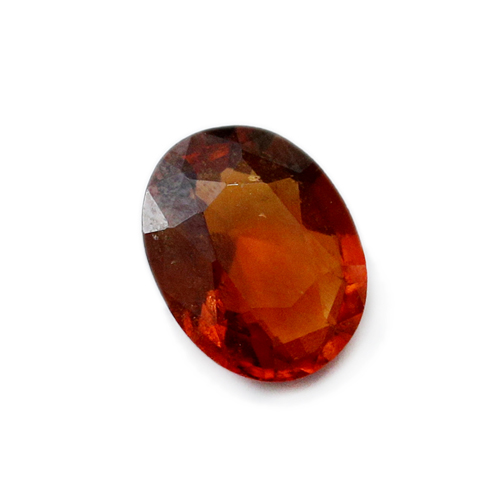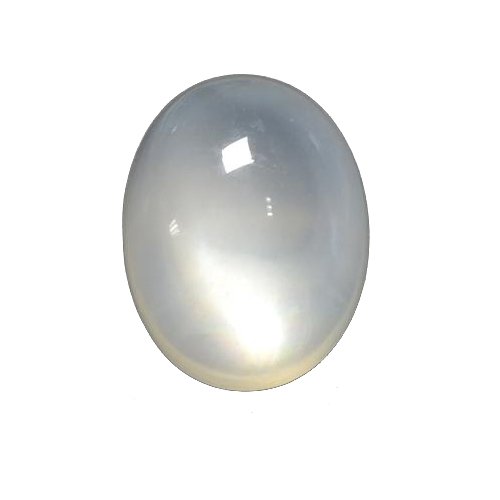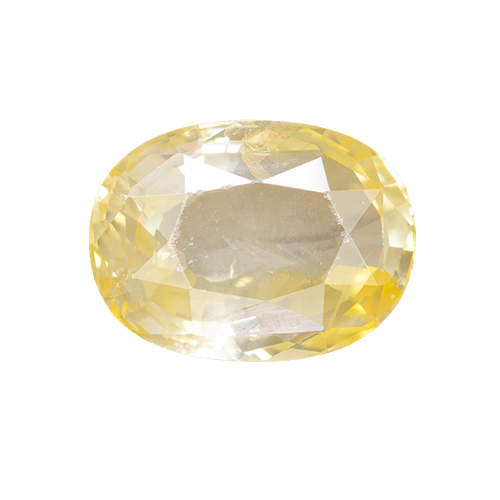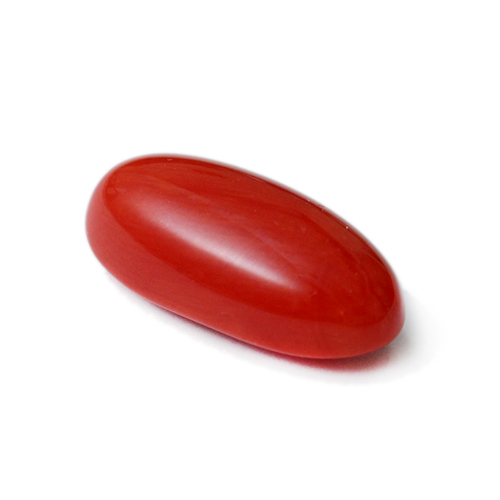
Every woman's ultimate jewel dream is never less than a diamond, and this shining transparent gem has its own superlative reasons. The gem stone with the highest hardness of 10 in Mohs Scale, Diamonds fall under the 'native element mineral' category. A favorable Venus in the natal chart is all you need to possess this romancing gem. Russia is inarguably the biggest Diamond miner till date. The quality of a finished Diamond is determined by the 4 C’s: Color, Cut, Clarity, Carat. Flawless and Colorless Diamonds are the rarest and command the toppest prices.

The honey- coloured Semi Precious gem belongs to the Garnet group of gems and is widely sourced from the mines of India and SriLanka. Believed to be ruled by the planet Rahu as per astrological convictions, Hessonite roots its title from the word ‘hesson’ meaning inferior. It is so called because, Rahu also called as Dragon Head is a malefic planet, thence the gem resonating the inferior planet couldn’t ask for a better derivation. The gemstone weighs 7 to 7.5 in Mohs scale. To be importantly noted is that, hessonite is not that gem which you can blindly pick to wear during the Rahu dasa. Hessonite has its own protocols in an astrological chart and only if the malefic planet stands in a benefic stand, this gem is ideal for you.

A variety of the beryl category of minerals, Emerald associates with the planet Mercury. A genuine Emerald will not be visually alluring with its heavy inclusions, and this is coincidentally the gem’s authentic identity. The algae-green stone weighs 7.5 to 8 in Mohs Scale and hence their resistance to breakage is very poor. You can bank upon this gem only if there is a favourable Mercury in the natal chart to enhance the intellectual qulitites for the wearer as it is presumed to be. Real Emeralds come from Zambia, Columbia and Brazil.

The Emerald substitute belongs to the rare Olivine variety. Yellowish green and deep geen hued peridots more commonly grab the spotlight. A softer gem than its precious counterpart, Peridot is often called ‘the evening emerald’ for its sheer color brilliance. Peridots weigh just 6.5 to 7 in Mohs Scale, and have pale blemishes and inclusions.

The violet transparent gem is an inexpensive substitute for Blue Sapphire. It is a very soft gem widely found in the mines of Brazil, Madagascar, SriLanka. The gem weighs 7 to 7.5 in Mohs Scale and belongs to the Cordierite mineral group. Linked to the astral planet Saturn, Iolite is ideal for those with a benefic position of Saturn in the natal chart. Iolite and Blue Sapphires have very less visual indifferences and this is crucial to note in a purchase

The shimmering presence called ‘aventurescence’ gave the gem its unique name. Belonging to the Quartz category, Aventurine is a cosmic green gem and is humorously titled as a ‘translucent quartz with a sparkle of mica’. Associated with the astral planet Mercury, Aventurine is again another inexpensive substitute for the precious Emerald. Majority of the Aventurines originate from India.

The opaque, green banded bright gem is found along the surface of underground caves as a Malachite cluster of stalactites and they are cut from these caves in pieces or slabs. Malachite is rather a soft gem with a Mohs Scale hardness between 3.5 and 4.0, and because of this, most gemstone collectors will treat the Malachite gemstone with a layer of resin or wax to add extra hardness and protection. Malachite is another preferred substitute for Emerald.

This is a Semi Precious gemstone found in the mines of India, Argentina, Brazil, Australia. Onyx originally has a band of alternating colors. Black and Green Onyx are the most renowned variety, the other shades being white, red and yellow. A visually charming gem with crystal clear surfaces, Onyx do undergo artificial treatments. The various colored onyx are linked with various planets in astrology. For example: Green Onyx is commonly used as a substitute for Emerald being linked with the astral planet Mercury, whereas a black Onyx can be used as a substitute for Blue Sapphire, being associated with the planet Saturn.

Alexandrite is a color changing gem and belongs to the Chrysoberyl category and is one of the rarest gem stones. With a heavy hardness of 8.5 in Mohs Scale, Alexandrite appears in green, blue, red, yellow, pink and even grey. For its unique color shifts, Alexandrite is often quoted as a gemstone which is ‘emerald by day and ruby by night’. Due to its scarce availability, Alexandrite is often more expensive than Diamonds. The gem stone first discovered in Russia is linked with the astral planets Sun and Mercury.

The blue hued gem stone belongs to the Silicate mineral group and again one of the rarest gem stones found in metamorphic rocks. Kyanite is an anisotropic gem, even the hardness can range from 4 to 4.5 on the Mohs scale, but when cut perpendicularly, its hardness can range from 6 to 7. Kyanite deposits are mostly found in India, Tanzania, Russia. Though the most desired variety is the blue shaded, the transparent variety of Kyanite is also renowned for its striking lustre and scarcity. The blue gem is linked with the astral planet Saturn.

Tourmaline belongs to the Cyclosylicate category and displays colors from brown, green, orange to red, yellow and green. The semi precious gem group has a hardness of 7 to 7.5 in Mohs Scale. Brazil has been the world's leading source of tourmaline till date, Brazilian tourmalines being the most opted for jewelry purposes. Green tourmaline is often used as a substitute for Emerald, whereas Red Tourmaline is a commonly sought substitute for Ruby.

The pale white hued organic semi precious gem originates from the deep sea and is actually a hard outer shell of the soft marine organism called Polyp. It is a very soft gem with a hardness of 3 to 4 only in Mohs scale and is dug out extensively from the coral reefs of Australia, America and the Mediterranean regions. Though white corals come under the coral group, they are ideally not preferred for a benefic Mars. For its white color, the gem is also linked with Venus.

Baptized for its glowing paleness that resembles the moonlight, Moonstone belongs to the feldspar group of minerals and is astrologically linked with the planet Moon. Though it is commonly available in an opaque pale shade, blue, grey and yellow moonstones are also renowned. Those with a favourable positioning of moon in the horoscopes can go for this 'Traveler’s stone' , as it is popularly known, to attract the radiant properties of the planet. If there is one planet whose malefic position can pull down all the benefic qualities of the others in the boat, it is Moon. An apt moonstone guarentees everything outside turbulence. Moonstone weighs just 6-6.5 in Mohs Scale, and hence can get damaged easily if not handled with proper care. The best Moonstones are mined from Srilanka, Brazil, Australia.

The pinkish blood red precious gem belongs to the Corundum group of minerals. The rich Chromium presence bestows the gem its striking red color. Again this is another gem other than Diamond whose quality is determined by the 4 C’S [COLOUR, CUT, CLARITY, CARAT] . A crystal clear gem commands its premium quality, but a Ruby without the minutest inclusions means it is extensively treated. Linked astrologically with the planet Sun, genuine rubies are sourced from Mozambique and Bangkok, the best available in the market as of now. Synonymous with luxury and gorgeousness, Ruby bestows nothing less than power, authority and dominance for the wearer if the native’s Sun in the natal chart owns up a qualified position. With a hardness of 9 in Mohs Scale, Rubies have the best hardness like a Diamond, and hence it is not easily breakable.

Belonging to the corundum group of minerals, the Yellow Sapphire gets its sparkling yellow hue from the traces of iron. It is astrologically associated with the largest planet Jupiter, and simply because of this it is hailed as an auspicious gem. Yellow Sapphire can only be used by those who have a favorable Jupiter in the horoscopes. With a comparatively high hardness of 9 in Mohs Scale, the scratch resistance quality of the yellow gem makes it an ideal choice for jewelry settings. SriLanka and Thailand have the best Yellow Sapphires mines.

Spotted for its impressive gleam, Blue Sapphire is one of the finest gems, which belongs to the corundum group of minerals. By virtue of its astrological links to pamper the black and most scary planet Saturn, Blue Sapphire is believed to bring sudden and active changes to the adorned. Only those who have a completely good Saturn positioning in the horoscopes should bank upon this blue gem. With a Mohs Scale hardness of 9, Blue Sapphire is one of the hardest gems next to Diamond making it zero prone to scratches or breakages. SriLanka ranks the top for Blue Sapphire mining, followed by Australia and Tanzania.

Distinct in its appearance and offbeat colour, Catseye belongs to the Chrysoberyl category of minerals. The gem is associated with the disfigured and troublesome planet Ketu. With its band of reflected light across the middle, the stone weighs 8 in Mohs Scale. Among the few gemstones that emits a special optical phenomenon, Catseye possess the unique quality called Chatoyancy, which means the light effect similar to the slit eye of a cat. Chrysoberyl Catseye are the most renowned in this genre being a very rare gem similar to an Alexandrite. Srilanka has the best Catseye mines.

A metaphor of being classified as rare and identified as the organic gemstone, pearls are composed of calcium carbonate and are found in the soft tissue of a living shelled mollusk and fossil conulariids. An ideal pearl is always perfectly round and smooth and it is astrologically linked with Moon. Moon reigns the emotional arena and those with an appropriate placement of the planet in the natal chart, wearing pearl is presumed to impart emotional equilibrium to the wearer. Pearls are one of the softest gems with just a Mohs Scale hardness of 2.5. They are subject to dissolvement with constant usages. Japan has the best Pearl Produce till date.

The first alternative for Yellow Sapphire, this golden yellow quartz variety is believed to boost concentration, enhance brain intellect stimulations, improving emotional balances and widening the spiritual arena. Yellow Citrine has a Mohs Scale hardness of 7, but it is prone to scratches. Madagascar has the best Citrine mines

The waxy lustred Semi Precious gem with spectacular inclusions hails from the Silica family with a Mohs Scale hardness of just 5.5 to 6. A distinct feature of this stone is the vivid play of colors called as Opalescence. Opals are available in pink, blue, yellow, red, black, though white and colorless are the most sought after choices. Coober Pedy in Australia has the world’s renowned Opal production. Due to its changing color patterns, Opals are linked with various planets though Venus tops the list.

The semi precious substitute of Ruby belongs to a group of Silicate minerals. Red Garnets are very common, though green, pink and even blue are also up in the market. Garnets doesn’t have visible inclusions. They have a Mohs Scale hardness of 6.5. Garnets should not be subjected to any hard blows or rough handling. Linked with the astral planet Ruby, the red gem is a most sought after jewel piece just like Pearls. India, Brazil and Srilanka have the majority garnet mines.

Roughly stated as an organic stone, Red coral is harvested inside seawater from the leaves of coral reefs. Linked with the planet Mars, Red coral has numerous physical and mental benefits, which can graciously be experienced by those with a suitable Mars in their horoscopes. Red Corals weigh just 3.5 in Mohs Scale and just like Pearls, they are subject to dissolvement with constant usage. Italian Corals dominate the market till date.

The intense blue semi precious substitute of Blue Sapphire is valued deeply for its color tone. Associated with the astral planet Saturn, lapislazuli is comparatively a softer gem with just a hardness of 5 to 6 in Mohs Scale. For its charming hue, the stone is usually worn as statement pieces. Afganistan tops the best lapis mines till date.

The brilliant blue inexpensive substitute of Blue Sapphire is sourced from the mines of Srilanka and Nigeria. For its blue hue, the gem is often confused with Aquamarines. This is comparatively an inexpensive semiprecious gem, but with a relative hardness of 8, its rather a tough gem.

Linked with the astral planet Mercury, Jade is again another popular substitute for Mercury. This interesting semiprecious gem sourced from the mines of Myanmar has a transparent clarity and inherent inclusions. With a Mohs Scale hardness of 6.5, Jade requires proper care to secure it from scratches.

Again yet another chatoyant gemstone like Catseye, Tigereye is a most sought out alternative for the yellow planet. The golden brown band is its hallmark identity and the gem has a silky lustre. Tigereye has a flipping mohs scale hardness from 6.5 to 7, and most often it is brittle and delicate. The blackish yellow gem is sourced from the mines of Australia and South Africa.

The popular alternative for Diamonds, Aquamarines are triumphed for its light sea blue hue and sparkling lustre. The beryl family member has a hardness of 7.5 to 8, yet it has a brittle nature. A favorable Venus in the chart qualifies to bank an aquamarine. Brazil, Moambique and Nigeria tops the serene gem’s production till date.

The authentic yellow tinted gem comes in thin organic inclusions and resinous lustre with just a Mohs Scale hardness of 2.5 making it one of the softest gem. The best Ambers are sourced from Madagascar.

The blue green opaque gem have a more smooth and solid lustre, while some of them may even exhibit a play of brown lines throughout the surface. The name Tourquoise means Turkish and this visually pretty gem is more picked as a statement jewel. California has been an active supplier of Tourquoise till date. It is basically a soft gem with a Mohs Scale hardness of 5 to 6.

The violet variety of Quartz is the first substitute of Blue Sapphire. Linked with the astral planet Saturn, Amethyst is always a detoxifier when it comes to spiritual, physical and emotional balance. With a Mohs Scale hardness of 7, Amethyst is prone to scratches and damages. The Semi Precious gem is procured mainly from the mines of Arizona and North Carolina.